A Hat in Time has come a long way to get here. It was originally announced as a Kickstarter project by indie developer Gears for Breakfast, headed by Jonas Kaerlev, and smashed it’s original funding goal of $30,000 by closing out at nearly 1000% funding at just over $296,000.
It’s a game that seeks to pay homage to the 3D platformers of yesteryear, as well as other beloved classics of the N64, GameCube, and PS2 era. Games like Super Mario 64, Banjo-Kazooie, and Psychonauts being cited specifically as major inspirations. The game also takes clear inspirations from series like The Legend of Zelda and Paper Mario.
It’s all a very nice sounding idea on paper, but as time has shown us again and again, even as recently as the divisive Yooka Laylee, capturing the magic of those old 3D platformers that inspired so many all those years ago can be very tricky, especially when trying to create something familiar yet fresh. So has A Hat in Time finally cracked the code for an inspired platformer that awakens the child in all of us, while also appealing to our adult standards of quality?
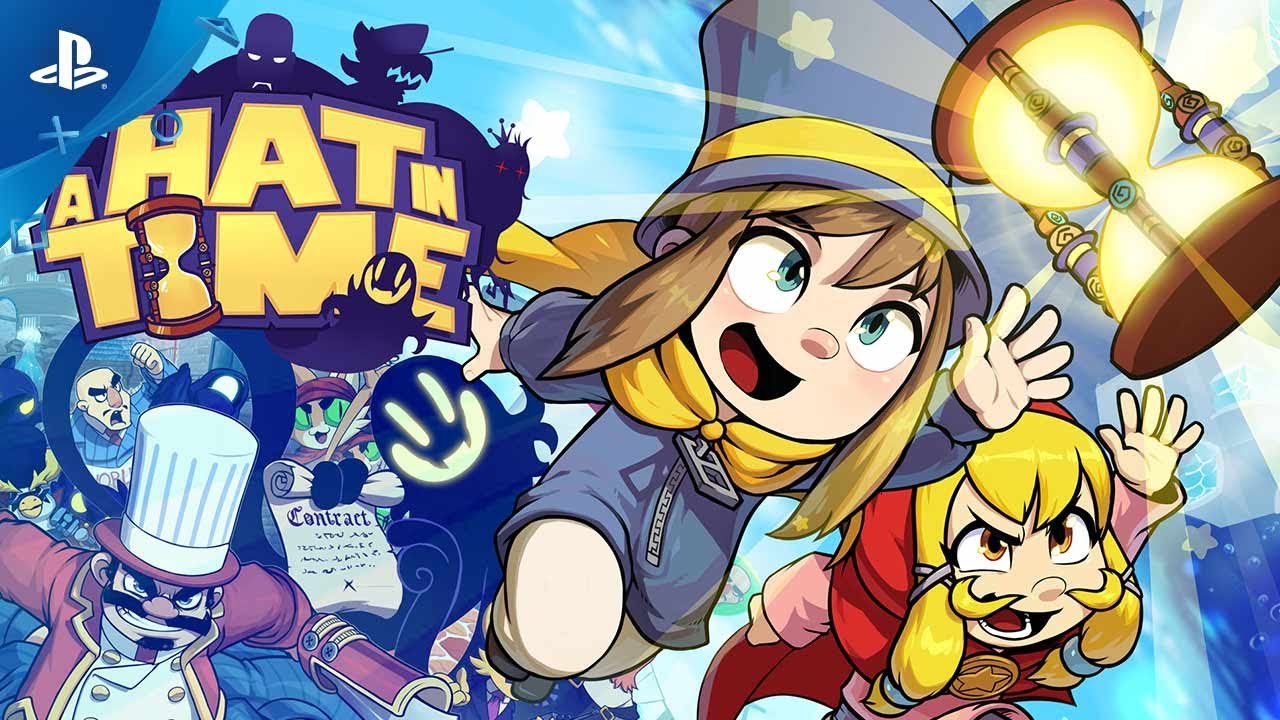 Let’s see if all the waiting has been worth it.
Let’s see if all the waiting has been worth it.
The “Cute as Heck” Presentation
Let’s get the story out of the way real quick. You play as Hat Kid, a little girl traveling alone in space when she suddenly loses her fuel source, 40 magic hourglasses called time pieces, and must travel down to a nearby planet to retrieve as many as she can in order to make it home. It’s a simple story, but with enough presence in the gameplay to give your quest some meaning, and enough twists and turns to really keep your attention.
While the graphics may not be that impressive for this day and age, with a lot of large mounds representing clusters of objects, a few slightly blocky or simple looking character models, and the occasional odd-looking texture, the game’s aesthetics more than make up for most of this. The choices of color and overall art design is wonderful, with every area feeling stylistically and tonally distinct from one another while still feeling cohesive to the game’s style as a whole. Even with some of these issues holding back the loots a tad, on the highest settings this game can still look fantastic.
It also helps that A Hat in Time has a ludicrously in-depth options menu that allows the player to tweak graphic and gameplay settings to their heart’s content. You can adjust the quality of everything from character quality to shadows in case you’re running the game on a weaker PC, raise the framerate to 175 FPS if you want, and there’s even options for a speedrun timer and automatically skipping all skippable cutscenes. Gears For Breakfast clearly wanted as many people as possible to be able to play their game, and kindly went out of there way to make it as technically flexible as they could.
If there’s one thing that A Hat in Time has in spades it’s charm. I can’t remember the last time I played a game that felt so friendly and welcoming. The characters and locations are all bright and colorful — even locations meant to be dimmer or foreboding have vibrant color palettes — and there was clearly a large amount of effort put into making the world feel alive. This is definitely a game with a personality — and that personality is boisterous and more than happy to invite you to it’s birthday party.
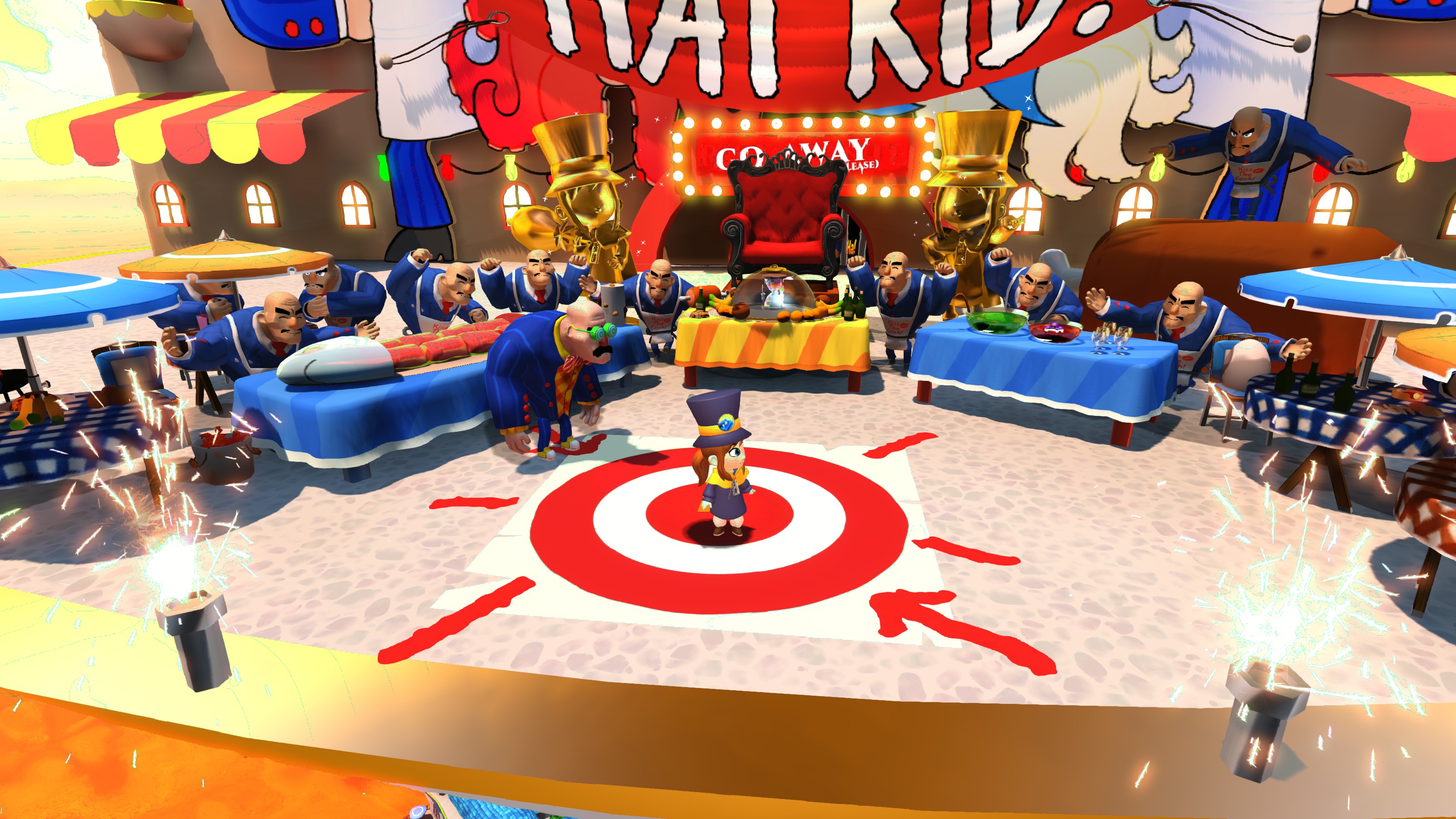 The party’s already started, and you’re the guest of honor.
The party’s already started, and you’re the guest of honor.
The game’s protagonist Hat Kid is a particularly expressive for a mostly silent protagonist as well. She feels a lot like a real kid, playful and kind, but also sometimes angry and sassy. She shows emotion in a number of subtle different ways, whether she’s stick her tongue out at a Mafia goon as she walks by him, or cowering under a table with a sad expression as she hides from danger. If the whole game is supposed to be “cute as heck”, then that would make Hat Kid the president of Heck.
I also found the game’s writing to be quite strong for a platformer. While A Hat in Time is not a story heavy game by any means, there are miniature plot-lines in each chapter, as well as a number of different characters fleshed out somewhat with cut-scenes and dialogue. The plot-lines had twists and turns that consistently surprised me, the few bits serious moments and accompanying dialogue were genuinely effective, and the game made me laugh very hard very often with all it’s jokes and gags.
I was also pretty flabbergasted by some of the darker jokes that the game managed to sneak in. There were references to suicide, murder, making deals with the devil, organized crime, and all sorts of crazy things I was honestly amazed they got away with, all the while the game standing around wearing it’s E10+ rating like a badge of honor.
The game’s narrative elements work their way into gameplay fairly often as well. Jokes are sometimes the solution to the problem, and narrative events can affect the outcome of a fight. There are also some levels with full mechanics that solely apply to that one level due to situational necessity. Overall, the writing did a fantastic job of adding weight to your adventure and tons of clever wit to the easy-going atmosphere the game has going.
The sound design also deserves special mention. The jingles for collectibles were also distinct and catchy, with every random goody you pick up giving you that little boost of confidence that they should in a game like this, and the cue for the level transition in particular always got me excited for what was coming, alongside the gorgeous title cards that came with each mission.
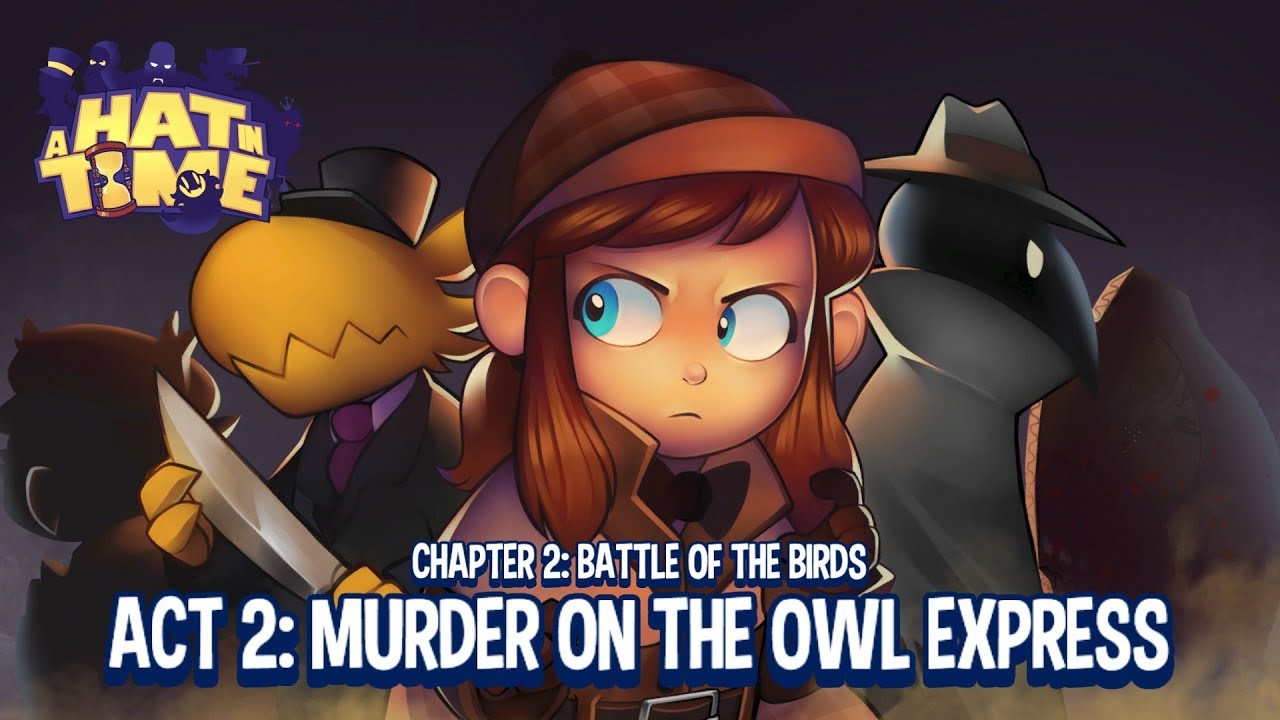 Title card for the mission “Murder on the Owl Express”.
Title card for the mission “Murder on the Owl Express”.
The soundtrack has been stuck in my head the last few days, as right from the get go it hits you with track after track of catchy-as-all-get-out platforming tunes that you’ll find yourself humming along to after only a few minutes. The soundtrack as a whole clocks in at a whopping five hours of original music across 78 tracks, and none of it feels low-effort or undercooked. From the spaceship hub theme guest composed by Grant Kirkhope that has you feeling calm and cozy, to the frantic theme to the “Train Rush” mission, to the various remixes of the main theme, the music had me invested in the on-screen action the whole way through.
Running, Jumping, Picking-Upping
While there is some light combat and a fair bit of collecting to be done, the main gameplay mechanic of A Hat in Time is the platforming. The controls and abilities that you start the game with give you a great sense of flow and precision. From the get-go you can easily run part-way up walls, jump off walls, double jump, dive in midair, and even chain most of these maneuvers together in order to cover a great distance and make it up tall platforms and across large gaps.
Most of the time I spent playing this game involved utilizing the platforming and movement mechanics to their full advantage in order to complete the stage or collect more goodies scattered across the usually wide-open maps. This brings me to the subject of collectibles, which in a collect-a-thon, are the bread and butter of the gameplay, which I am happy to say A Hat in Time understands very well.
While there are only 40 time pieces to collect, which does sound rather low compared to a number of other similar collect-a-thons, every level hides oodles of money and secrets to search for and collect, on top of the grand variety of mission objectives. What’s important in games based mostly around collecting things is to make sure that every collectible has a purpose, which again, A Hat in Time understands very well.
Money can be used for all sorts of useful things, such as unlocking certain levels, purchasing badges that allow you to upgrade yourself and customize your playstyle however you want, and even activate displays for special relics you find throughout the levels, which when done correctly gives you both a decoration for your hub as well as access to a bonus challenge level. Money is all over the place, and following it can lead to even more secrets. Just wandering any give level with little direction following the trail of pocket change feels like your making progress.
You can also find tokens in levels that give you access to a slot machine in the main hub where you can pick between one of three random prizes. These can be alternate colors for Hat Kid’s outfit, to remixes of certain songs in the game, to alternate designs for your different hats. There’s just a lot to find and a lot to do with what you find, which keeps the reward cycle constant. It also helps that the levels are all quite well-designed and visually appealing, which further encourages exploration and further mastering your abilities.
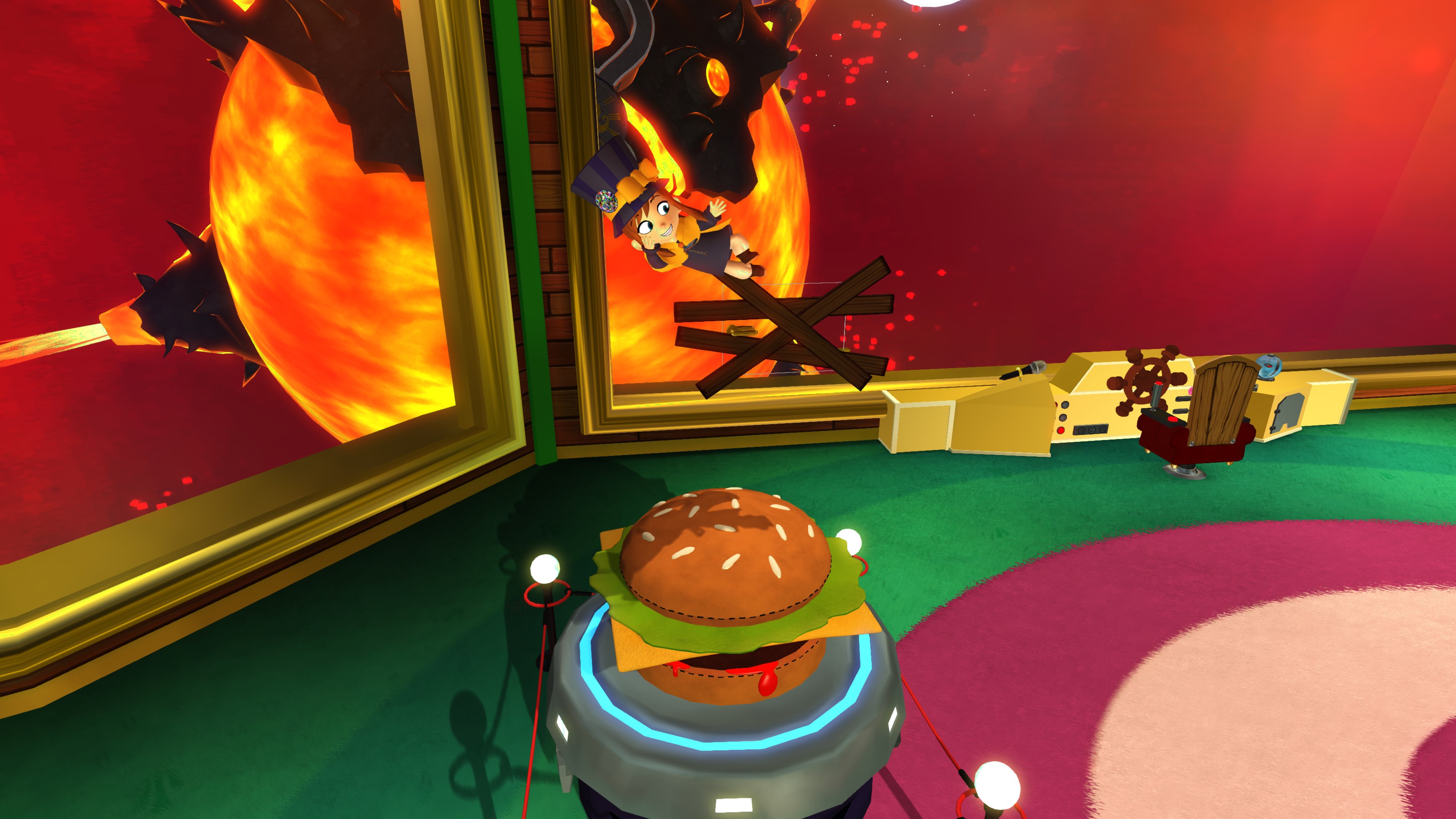 Explore enough and you’ll be bouncing off a burger in no time.
Explore enough and you’ll be bouncing off a burger in no time.
Then there are the balls of yarn you can find. Throughout the levels you can find different kinds of yarn balls, and if you manage to both find the correct kind as well as enough of the stuff, you can knit yourself a new hat that acts similarly to new item in the Zelda series, and unlocks a new ability for progression you can use by equipping that particular hat. These things can range from a sprint function, to a ground pound that let’s you travel across the map in special ways, to throwing handy explosives to blow up certain objects.
Having brought up the Zelda series, let’s talk a bit about references. I have seen plenty of games that take clear inspiration from others, as well as plenty that outright directly reference what they’re inspired by, but it’s been quite a while since I’ve seen one that did it quite as lovingly and blatantly as A Hat in Time.
There were visual callbacks to Super Smash Bros., Super Mario Galaxy, Super Mario Sunshine, Psychonuats — the list goes on. On top of the badge system being very reminiscent of the Paper Mario series, there were also a few particular visual callbacks to that series that to me — as a huge Paper Mario fan — just screamed homage.
Like, the kind of references that are so specific and so non-memetic that you’d practically have to be somebody who grew up with these games and loved them like the developers did in order to catch them. If you don’t believe me then just look at this:
@HatInTime Don’t think I don’t see you Gears For Breakfast… You like Paper Mario, don’t you? pic.twitter.com/KVHn5LtSSq
— Greyson Ditzler (@BrowFurrowed) October 4, 2017
What Could Have Potentially Been Better
I personally had few issues with A Hat in Time’s design, but there were still a few things that I feel could have been a little better polished.
Most of my big gripes with the game come in the form of technical issues. I unfortunately ran into multiple crashes, almost always after returning to the hub or loading a new level, and frame dips happened to me often in a number of areas even when there wasn’t much going on.
Going back to the graphics for a moment, while the game still does look nice on the lowest settings, even on higher settings some textures just looked like stickers on top of models at times, and sometimes they would just fail to load, and this would cause some particle effects to be replaced by pattern tests or a series of specks trapped in a square.
Just for reference, I played this game on my laptop, which is not particularly suited for gaming, but could still run the game fairly well on lower settings nonetheless. I am fully aware that my weaker PC was likely the source of a number of these issues, but it still hampered my experience regardless, and I’ve heard of other people with stronger PC’s running into issues with the framerate and textures as well.
Lastly, I honestly wish their had been a bit more combat and boss fights. Don’t get me wrong, the core gameplay is still tons of fun with the combat as low-key as it is, but for a 3D platformer I thought the options available to you for battles was pretty impressive, and I wanted to see more out of it. Plus, I thought that every boss fight was just fantastic with their complicated patterns and lots of great banter with your opponents. I just wish there was more of that to appreciate. None of this seriously affected my overall experience — expect for the crashes — but they are things that I hope are addressed in the future free content updates that Gears for Breakfast has promised us.
Has Gears for Breakfast Succeeded?
At time of writing, I have not 100% completed A Hat in Time, but I definitely plan to. For this review I decided to simply play to the end of the main story, but I still played at my own pace and took my time getting there. I finished the game after about 13 hours and I could easily see getting all the remaining collectibles taking another 3-4 hours on top of that, so I feel the game hits the sweet spot in terms of length, where it’s long enough to be satisfying but not feel bloated.
I’d be lying if I said I didn’t have an absolute blast while playing A Hat in Time. Some of the technical difficulties did hamper my experience a bit, and on one or minuscule occasions the game’s design got on my nerves, but that didn’t stop from playing for hours at a time with a huge smile on my face. I’d even say that I love this game — but that comes with a qualifying statement.
My score doesn’t go any higher than it is because the technical issues and relatively small-scale do hold it back just a bit, but I can easily see that being fixed. If some of the performance issues were updated with future patches, and depending how solid the local co-op update is, as well as how substantial the two planned free DLC chapters are, I could see my score going up further and this game being boosted into the status of a definitive 3D platformer classic.
But regardless of all it’s slight issues, I still think that Gears for Breakfast have succeeded. They’ve managed to create a game that serves as a spiritual successor to a beloved genre of games, as well as take great inspiration from the titles they love themselves, and make something well-designed and very personal that feels like a glimpse back in time and a step forward all at once. I heartily recommend A Hat in Time to anybody who loves 3D platformers, charming comedic games, or anybody just looking for something full of love and imagination.
A Hat in Time is available now for $30 on PC, and is expected to come out on PS4 and Xbox One later this Fall. You can watch a trailer for the game below:
[Note: Review copy provided by Humble Bundle]

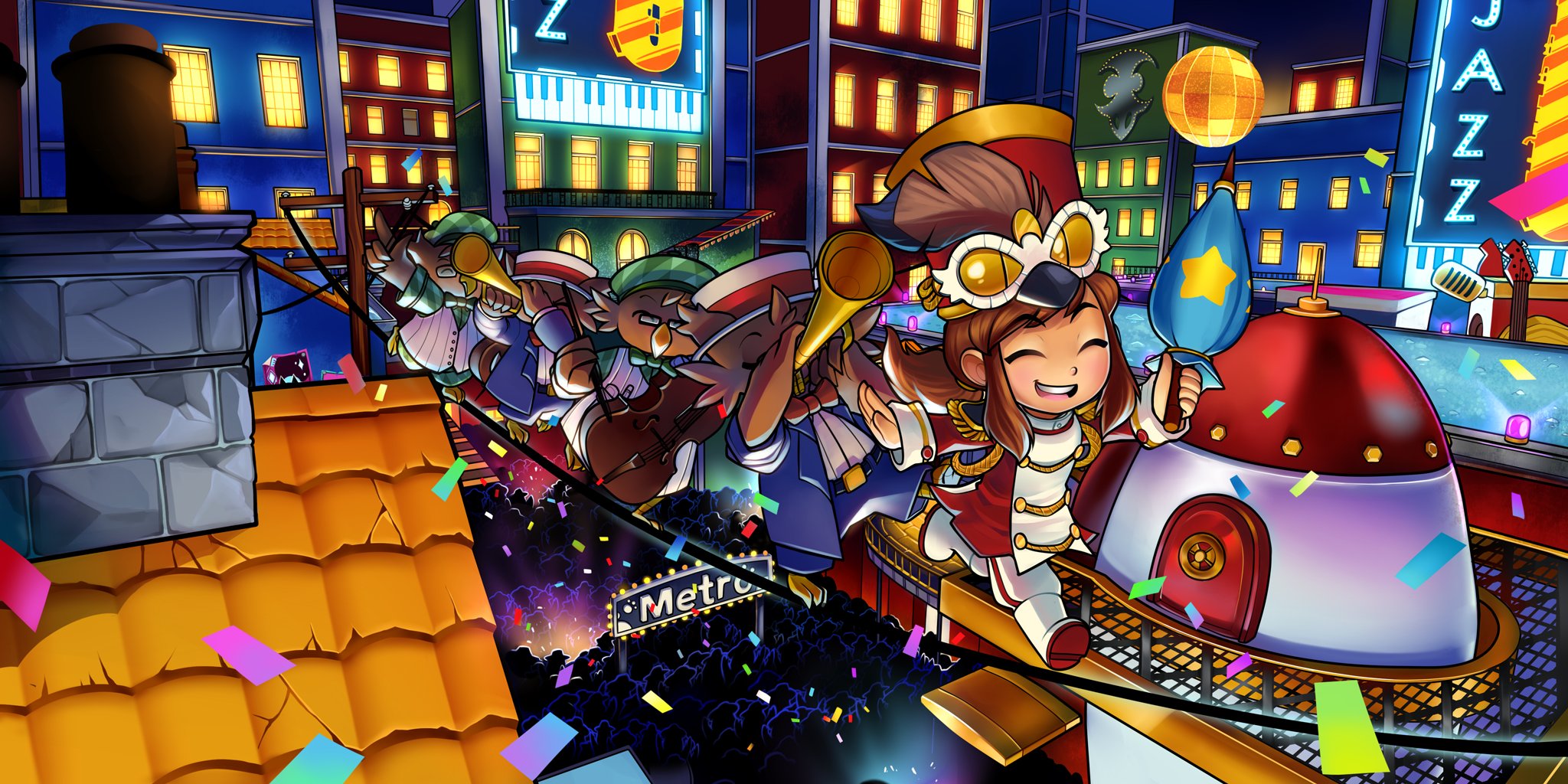





Published: Oct 7, 2017 06:45 pm